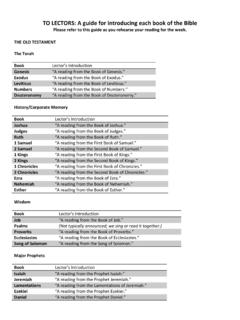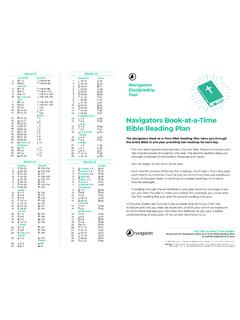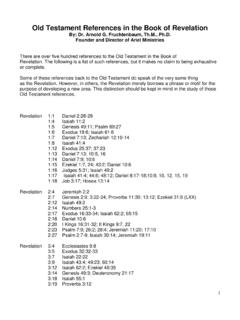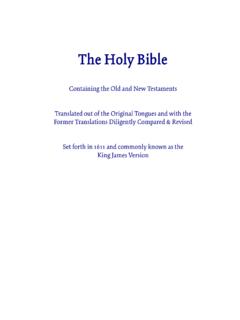Transcription of The Book of Amos - New Christian Bible Study
1 The book of Amosfrom the bookMinor Prophets: Major Messagesby Rev. George To Use This Study and Minor Was This Man Called Amos?..9 What Conditions in the Northern Tribes Made Amos Prophecy Necessary?..10 Chapter 1 1 1 1 1 1 2 2 2 2 2 3 3 3 3 3 3 4 4 4 4 4 4 5 5 5 5 5 5 5 5 6 6 6 6 6 7 7 7 7 7 7: 8 8 8 8: 9 9 9 9 9 9 : A Summary of the Nine Chapters of book of Amos is one of the books of the Word. Not much has been written aboutit in the New Church. Since I started working on this Study of Amos, I have searched our library holdings with the hope I would turn up a hidden or forgotten Study by some New Church scholar.
2 Although there are sermons using a verse or part of a chapter of Amos as a text, I have found no detailed Study of Amos or other books of the Minor Prophets. Why not? Is there a perception that the Writings lack a verse-by-verse explanation of these Prophets?So far, my research has uncovered several thorough New Church books on the Major Prophets, such as Isaiah, Daniel, and Ezekiel. The absence of similar books on the Minor Prophets motivated me to undertake a Study guide approach to filling this void. I hope this first Study guide will prove helpful to others and that additional Study guides will follow this one. Ultimately, I want the Minor Prophets to be accessible and hope to contribute to their Study and use in the church.
3 Most of all, I dlike this effort to be a challenge so that others will be encouraged to build on and improve this pilot To Use This Study slow, unhurried reading of Amos is essential. Read each chapter before you look at the related section of the Study guide. Read the chapter again while you are using the Study guide, and read it a third time when you are finished. This process will give you a powerful sense of the series of events and meanings in each chapter. It is important to feel comfortable with all the names, places, and announcements in Amos prophecy. When possible, some historical information will be included in the Study guide to increase reading comprehension and enhance book of Amos is not an easy work to read and understand.
4 Unlike some of the prophets Jonah or Hosea Amos doesn t tell a story that is easy to remember. He brings prophecies against neighbors of Israel, mentioning names and places one can only recognize with the help of maps and reference books. One has to wade through many historical facts to catch a glimpse of the message in Amos, so it is important to balance history with solid research of the spiritual sense. Researching can require a table full of books and hours of comparing and contrasting meanings that can be drawn from the internal sense. This Study guide intends to help the researcher by including a full set of quotes so that he orshe may spend less time juggling books and more time reflecting on the issues the internal sense presents.
5 My hope is that the reader will concentrate on the process of applying doctrine to you read Amos, there are several resources you will want to use with this Study guide. The first is a book of the Writings called Summaries of the Internal 6 Sense of the Prophets and This work includes a verse-by-verse overview of each of the nine chapters of Amos. The overview gives a general statement about the internal sense. Our research will move us toward the particulars of the internal important reference tool is Searle s General Index to Swedenborg s Scripture Quotations. This reference shows where in the Writings a verse(s) of the Word is either explained specifically or used to illustrate a doctrinal point that we can add to our Study .
6 There is also another use of this work. As we Study ,each researcher will be led by the Lord s Providence in myriad of ways and according to specific needs or states. Knowing how to use this book will help us look up related passages in the Word that will add to our knowledge of the three-fold Word. will soon discover that not every verse, word, name, etc. is directly quoted and explained in the Writings. However, there are often references to the same name, place, or thing in the explanation of a different verse of the Word. The hope is that reflection on these other references and their associated doctrine will help us see possible applications to our Study of Amos.
7 We will need to use derived doctrine. Please don t run away from this maligned term. If we use it properly, admitting openly that it is derived, we bring no harm to the internal sense. Think about it for a minute. The Writings give us a verse-by-verse explanation of Genesis, Exodus, and Revelation. Do we stay away from the other books of the Word because the Lord didn t reveal them in the Writings in the same way He did Genesis, Exodus, and Revelation? I think not. We must look for, find, and wisely use derived doctrine with a humble acknowledgment that we have tried to apply doctrine with a degree of human prudence. a notebook handy during your Study times. Write out insights, questions, and any summaries you find helpful in organizing your thoughts about each chapter.
8 The goal of this Study guide is not to give a detailed summary of the internal sense but to start the researcher s quest for deeper is a wonderful explanation of Amos, chapter 8, in the Dole Bible Study Notes, Volume 4. There you will see an example of historical and spiritual information corroborating one another. It is well worth your time to read and reflect on this explanation. You might also enjoy looking at the Sower Notes, Volume III, Chapter the end of each chapter in the Study guide, you will find a Study review. The review includes a summary of each section to help you reinforce and build on your understanding of several of the key each Study unit with a devotional prayer asking the Lord to guide and direct your thoughts.
9 Certainly beginning in this sphere has the power to inspire and open our minds with a higher spiritual priority that will keep us in the company of the Lord s angels. As the Writings teach, we must seek to love truth for truth s sake. Such an approach will free each reader from preconceived ideas that might limit his or her ability to see the intent and message of the Lord s Word. 17 IntroductionBefore we begin our Study , it will be helpful to learn some background information about the books of the prophets and their approximate AND MINOR PROPHETSLet s begin with a brief description of what the terms Major Prophets and Minor Prophets mean. In the Old Testament, there are 16 books referred to as the books ofthe Prophets.
10 Biblical scholars have divided the 16 books into two categories. Augustine was the first person to use the terms Major and Minor to indicate the size of the books, not their relative importance. The Minor Prophets contain fewer chapters than those of the Major do not agree on the timeline of the prophets. I found at least ten different timelines. None of them agree completely on dates. If I were to simplify the researchinformation I would say there are essentially two timelines that seem to have the acceptance among the scholars. So I offer both for your Minor ProphetsAmos 750 BC * Obadiah 840-830 BCHosea 745-734 BC * Joel 830-750 BCMicah 701 BC Jonah 780-740 BCZephaniah 628-626 BC Hosea 765-725 BCNahum 614-612 BC Amos 760 BCHabakkuk 605-600 BC Micah 740-700 BCHaggai 520 BC Nahum 640-620 BCZechariah 520-519 BC Zephaniah 640-609 BCMalachi 460 BC Habakkuk 680-605 BCObadiah 400-350 BC Haggai 520 BCJoel 350 BC Zechariah 520-480 BCJonah 300 BC malachi






